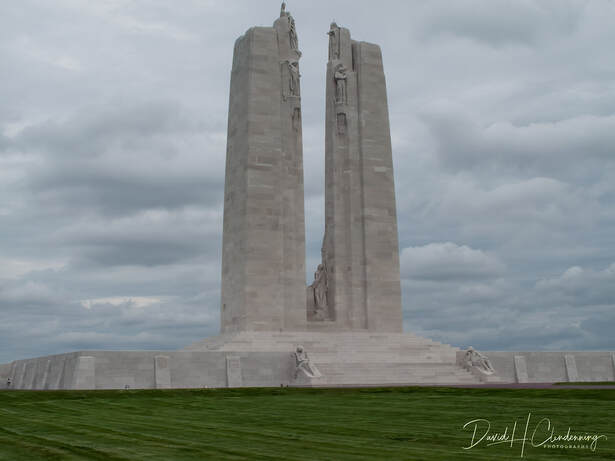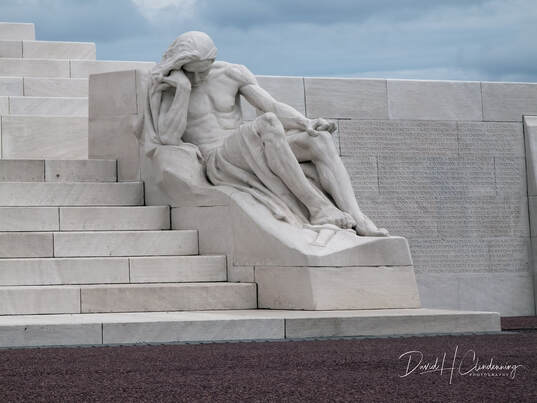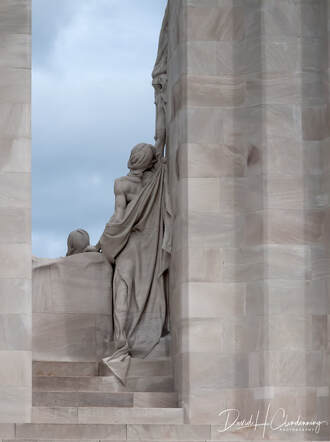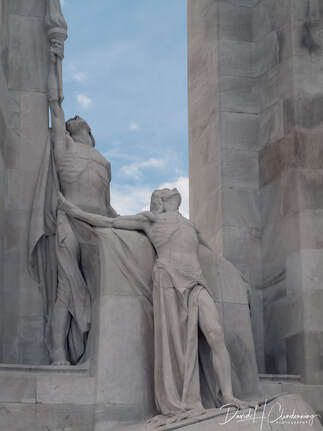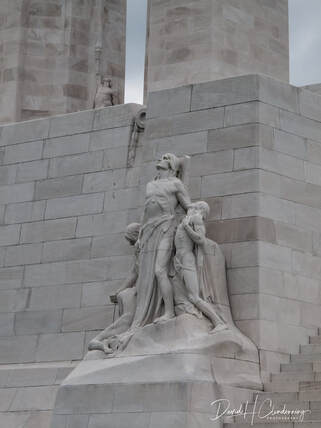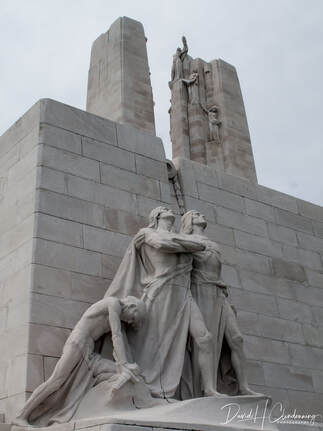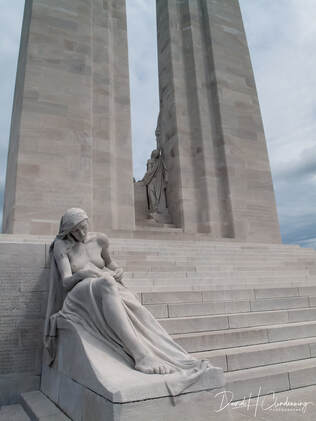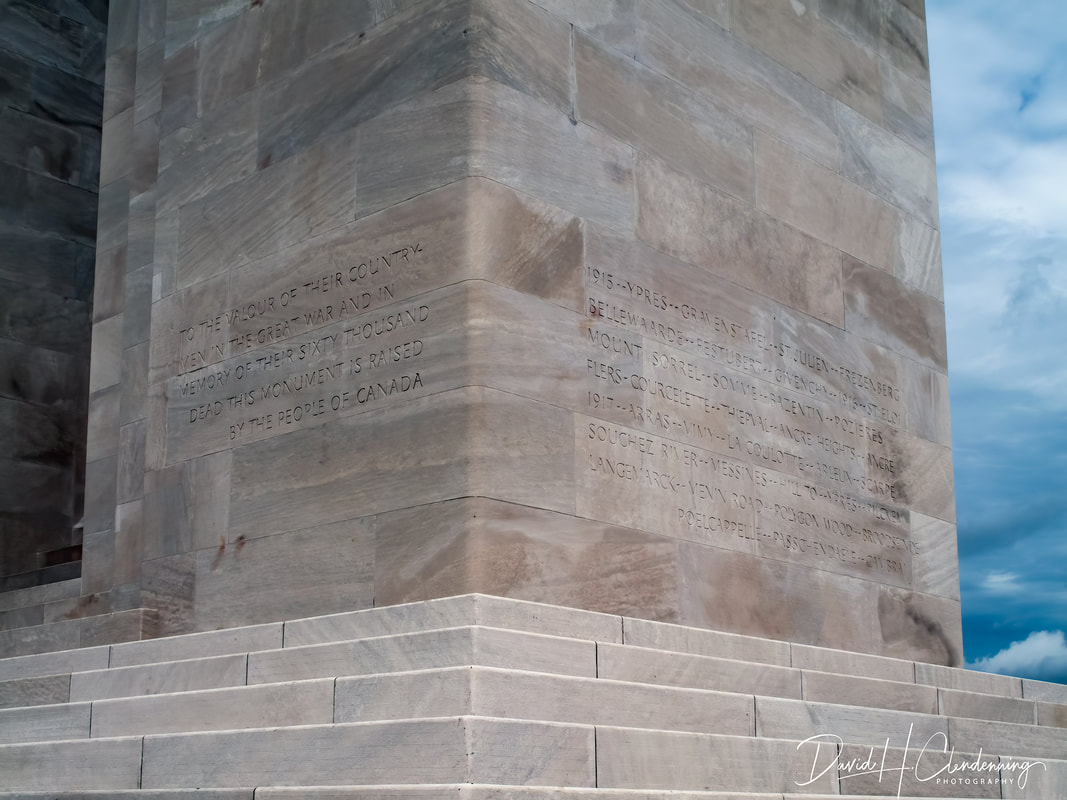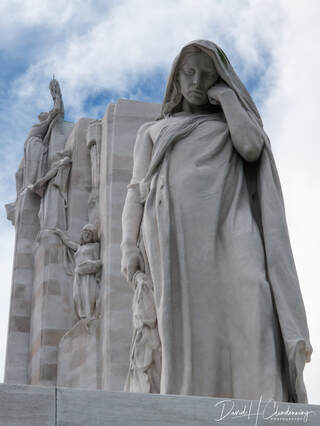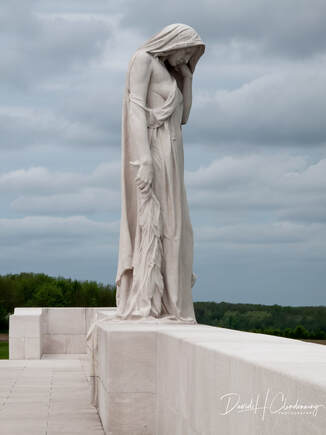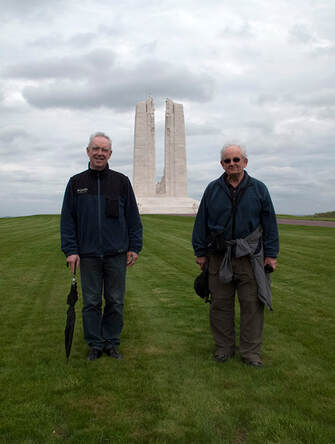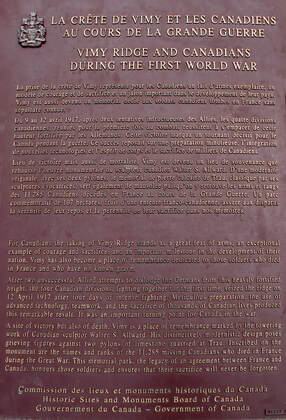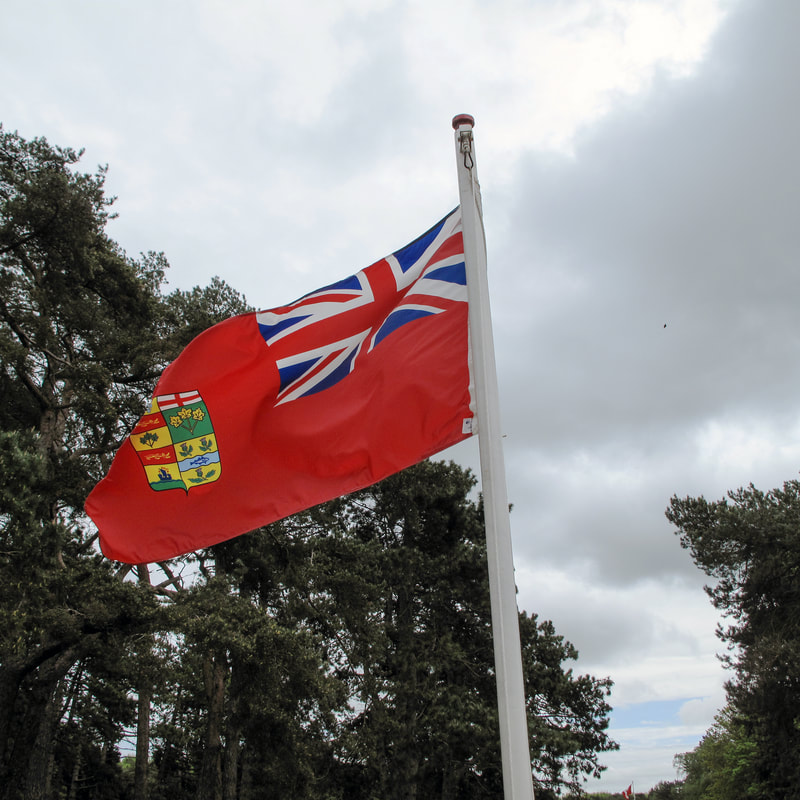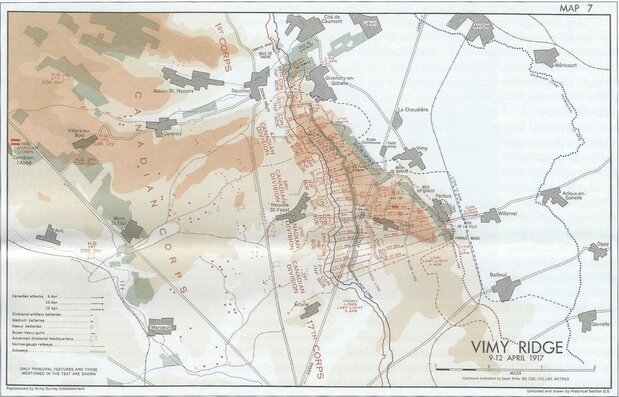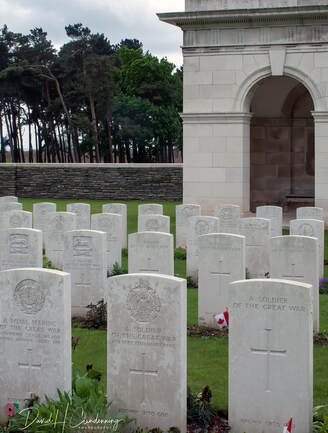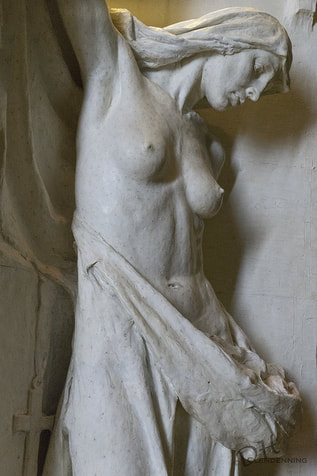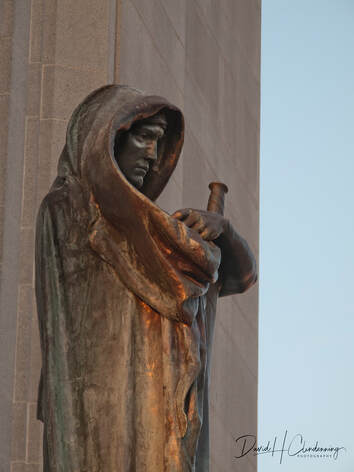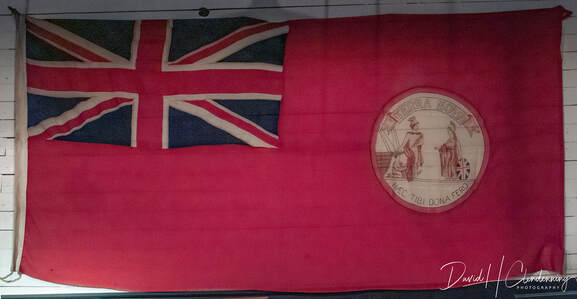The Great War 1914 - 1918
Vimy Ridge Memorial, Northern France
Of the 650.000 Canadians that served on the battlefront in The Great War, 60,000 never came home and nearly 200,000 were wounded.
Prime Minister to travel to France for the 100th anniversary of the Battle of Vimy Ridge
March 24, 2017
Ottawa, Ontario
The Prime Minister, Justin Trudeau, announced today that he will travel to France from April 8 to 10, 2017, to attend commemorations for the 100thanniversary of the Battle of Vimy Ridge. He will join His Excellency the Right Honourable David Johnston, Governor General of Canada, Their Royal Highnesses The Prince of Wales, the Duke of Cambridge, and Prince Harry, as well as Kent Hehr, Minister of Veterans Affairs and Associate Minister of National Defence, Harjit Sajjan, Minister of National Defence, and General Jonathan Vance, Chief of Defence Staff for the Canadian Armed Forces.
Quotes
“The Battle of Vimy Ridge was a turning point in the First World War and for Canada, when Canadians acted – and fought – as one. At Vimy Ridge, we will mark this great victory, and pay tribute to every Canadian who answered the call to serve. Canada enjoys peace and freedom today because of their sacrifices, for which we are forever grateful.”
— Rt. Honourable Justin Trudeau, Prime Minister of Canada
“The victory at Vimy Ridge was made possible through the combined efforts of Canada and its allies. It is fitting 100 years later to walk side-by-side with our allies to reflect on our victory, commemorate this milestone, and renew friendships as we continue to work together to defend freedom and democracy around the world.”
— Rt. Honourable Justin Trudeau, Prime Minister of Canada
Quick Facts
March 24, 2017
Ottawa, Ontario
The Prime Minister, Justin Trudeau, announced today that he will travel to France from April 8 to 10, 2017, to attend commemorations for the 100thanniversary of the Battle of Vimy Ridge. He will join His Excellency the Right Honourable David Johnston, Governor General of Canada, Their Royal Highnesses The Prince of Wales, the Duke of Cambridge, and Prince Harry, as well as Kent Hehr, Minister of Veterans Affairs and Associate Minister of National Defence, Harjit Sajjan, Minister of National Defence, and General Jonathan Vance, Chief of Defence Staff for the Canadian Armed Forces.
Quotes
“The Battle of Vimy Ridge was a turning point in the First World War and for Canada, when Canadians acted – and fought – as one. At Vimy Ridge, we will mark this great victory, and pay tribute to every Canadian who answered the call to serve. Canada enjoys peace and freedom today because of their sacrifices, for which we are forever grateful.”
— Rt. Honourable Justin Trudeau, Prime Minister of Canada
“The victory at Vimy Ridge was made possible through the combined efforts of Canada and its allies. It is fitting 100 years later to walk side-by-side with our allies to reflect on our victory, commemorate this milestone, and renew friendships as we continue to work together to defend freedom and democracy around the world.”
— Rt. Honourable Justin Trudeau, Prime Minister of Canada
Quick Facts
- More than 650,000 Canadians served in the First World War, which lasted from 1914 to 1918.
- The Canadian assault on the German positions at Vimy Ridge began on Easter Monday, April 9, 1917.
- The Battle of Vimy Ridge lasted four days, ending with an impressive Canadian victory. This was the first action in which all four divisions of the Canadian Corps – representing every region of our country – fought together side-by-side on the same battlefield.
- Of the more than 10,600 Canadian casualties at Vimy Ridge, some 3,600 soldiers lost their lives.
- Four Victoria Crosses were awarded to Canadian soldiers for their bravery at Vimy Ridge.
- The Canadian National Vimy Memorial was designed by Canadian sculptor and architect Walter Seymour Allward. It was unveiled on July 26, 1936, by King Edward VIII. Inscribed on the base of the memorial are the names of 11,285 Canadians who lost their lives in France during the First World War and then had no known graves.
- Canadians are encouraged to follow the commemorations via social media by using #Vimy100.
|
Canadians wanted to honour the sacrifices of the Great War and in 1919 the Memorials Committee in Canada was created to decide on where Canada would commemorate her victories and honour the fallen. The report to the Canadian Parliament selected eight sites and a competition for Canadian architects and sculptors was held. Finally, it was decided one distinctive memorial should be built to mark Canada's greatest victory.
Canadian Monument sculptor and architect The monument was designed by Canadian monument sculptor and architect Walter Seymour Allward (1875-1955). When asked about the design, Allward said he took if from a dream, his vision of the two pylons, one for Canada and the other for France, acting as a heavenly gate. The Canadian National Vimy Memorial stands on Hill 145 on Vimy Ridge near Arras, France and is Canada's largest and principal overseas war memorial. It was unveiled in 1936 by King Edward V111, in the presence of President Albert Lebrun of France. The Battle of Vimy Ridge, 9-12 April 1917 (being part of the larger offensive of the Battle of Arras in the Nord-Pas-de-Calais region) has considerable significance for Canada. It was the first instance in which all four divisions of the Canadian Corps, made up of troops drawn from all parts of the country, fought as a cohesive formation against three divisions of the German Sixth Army. The battle was part of the opening phase of the British-led Battle of Arras, a diversionary attack for the French Nivelle Offensive. The objective of the Canadian Corps was to take control of the German-held high ground along an escarpment at the northernmost end of the Arras Offensive. This would ensure that the southern flank could advance without suffering German enfilade fire. Supported by a creeping barrage, the Canadian Corps captured most of the ridge during the first day of the attack.. The town of Thelus fell during the second day of the attack, as did the crest of the ridge once the Canadian Corps overcame a salient of considerable German resistance. The final objective, a fortified knoll located outside the town of Givenchy-en-Gohelle, fell to the Canadian Corp on 12 April. The German forces then retreated to the Oppy-Mericourt line. Historians attribute the success of the Canadian Corps in capturing the ridge to a mixture of technical and tactical innovation, meticulous planning, powerful artillery support and extensive training, as well as the failure of the German Sixth Army to properly apply the new German defensive doctrine. The image of national unity, achievement and sacrifice is what gives the battle importance for Canada. Vimy Ridge was the most significant and deadly battle for Canadians in WW1. |
Canadian Expeditionary ForceThe battle was the first occasion when all four divisions of the Canaidan Expeditionary Force participated in a battle together and thus became a Canadian symbol of achievement and sacrifice
Construction of the monumentA 250 acre portion of the former battleground serves as a preserved memorial park and site of the Canadian National Vimy Memorial
|
It took Walter Allard two years to source the limestone an abandon Roman quarry on the Dalmation coast, which is now part of Croatia. Six thousand tons were quarried and shipped. The work started in 1923 and the first job was to clear the site of unexplored shells, trenches, dugouts and mine craters. The network of tunnels used by the troops to reach the front line had to be filled and each part in the construction site had to dug by pick and shovel, resulting in many men injured and killed.
War and Peace Ever Linked Together
In the base foundation, 15,000 tons of concrete and steel bars were used to support the pylons. On and around the memorial are 20 double life-sized statues, all carved on-site. The most noticeable is the main statue facing the Douai Plain, "The Spirit of Canada Mourning Her Fallen Sons, ", sculpted from a single 30-ton block of limestone.
In the centre of the bastion is the tomb of the Fallen Canadian Soldier and around the base in scribed the names of 11,169 missing Canadians with no known graves, lost during the fighting in France.
Restoration of the Monument 2005-2007
The restoration of the Vimy Memorial took place over a two-year period and was completed in 2007.
War and Peace Ever Linked Together
In the base foundation, 15,000 tons of concrete and steel bars were used to support the pylons. On and around the memorial are 20 double life-sized statues, all carved on-site. The most noticeable is the main statue facing the Douai Plain, "The Spirit of Canada Mourning Her Fallen Sons, ", sculpted from a single 30-ton block of limestone.
In the centre of the bastion is the tomb of the Fallen Canadian Soldier and around the base in scribed the names of 11,169 missing Canadians with no known graves, lost during the fighting in France.
Restoration of the Monument 2005-2007
The restoration of the Vimy Memorial took place over a two-year period and was completed in 2007.
The majestic and inspiring Vimy Ridge Memorial overlooking "consecrated ground"
THIS LAND IS THE FREE |
CE TERRAIN À ÉTÉ CONCÈDE |
"The Spirit of Canada Mourning Her Fallen Sons"
"Canada entered the war as a junior partner of Great Britain and emerged as an equal given her own seat and vote at the League of Nations."
Canadian author Pierre Berton
The Canadian Corps at the Battle of Vimy Ridge Click map and images to enlarge
Canadian War Art - Legacy of the Conflict
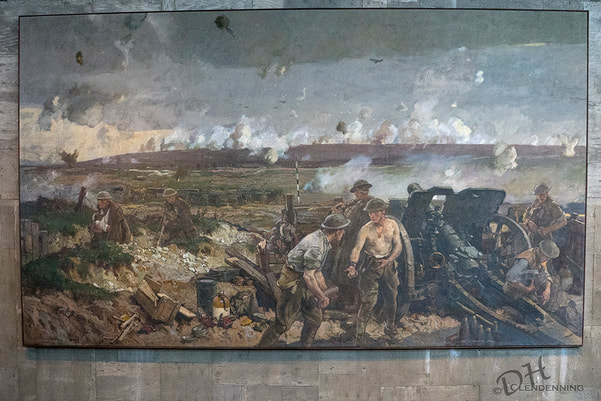 Alfred Bastien, Canadian Gunners in the Mud, Passchendaele, Canadian War Museum, Ottawa
Alfred Bastien, Canadian Gunners in the Mud, Passchendaele, Canadian War Museum, Ottawa
War artists who served in the First and Second World War included prominent Canadians like Arthur Lismer, A.Y. Jackson, Frederick Varley, Alex Colville, Lawren P. Harris, Pegi Nicol MacLeod and Jack Nicois.
Canadian War Graves
More than 7,000 Canadian soldiers are buried in 30 war cemeteries within a 20-kilometre radius of the Vimy Memorial. |
The names and burial locations of 118,000 Canadians (61,000 in WW1) who fell in military service, from the days of the Boer Wars to the Afghanistan mission can be found on a new digital map, part of The Fallen, a free computer application that a Toronto software firm, Good Digital Culture, released on Remembrance Day, 11 November 2013.
…Only the poppy survives.
A War of Inches
This war over land was fought in trenches. The area known as Flanders in western Belgium is low-lying agricultural land supported by a system of canals. It was important to both sides of the conflict because it offered access to the North Sea. It was here that Major John McCrae was sent as the 42 year old surgeon to First Brigade Artillery. The area contained a very large contingent of Canadian military, providing back up to the French and Algerians.
This war over land was fought in trenches. The area known as Flanders in western Belgium is low-lying agricultural land supported by a system of canals. It was important to both sides of the conflict because it offered access to the North Sea. It was here that Major John McCrae was sent as the 42 year old surgeon to First Brigade Artillery. The area contained a very large contingent of Canadian military, providing back up to the French and Algerians.
Canadians' gallantry in the trenches of Flanders
"It was hell all the time. We really expected to die in our tracks. We never had our boots off, much less our clothes."
Major John McCrae, MD
Appointed in January 1918 as Consulting Physician to the British Armed forces with rank of colonel, McCrae moved away from the front lines. Contracting pneumonia and suffering from cerebral meningitis, he died on January 18. He is buried with full military honours in Wimereux, France.
“In Flanders Fields”
In Flanders Fields the poppies blow
Between the crosses row on row,
That mark our place; and in the sky
The larks, still bravely singing, fly
Scare heard amid the guns below.
We are the Dead. Short days ago
We lived, felt dawn, saw sunset glow,
Loved and were loved, and now we lie
In Flanders fields.
Take up our quarrel with the foe
To you from failing hands we throw
The torch; be yours to hold it high.
If ye break faith with us who die
We shall not sleep, though poppies grow
In Flanders fields.
By: Lieutenant Colonel John McCrae, MD (1872-1918)
Canadian Army
First published in December 1915, McCrae’s “In Flanders Fields” remains to this day one of the most memorable war poems ever written.
Major Canadian Battles in the First World War
The Great War 1914 - 1918
Go to: http://ww1.canada.com
The western front in the first world war and now - interactive
Go to: Guardian Newspaper, UK
- Battles of Gravenstafel Ridge and St. Julien, April 23 to May 5, 1915. - Second Ypres Canadian Casualties: 6,064 wounded and killed.
- Vimy Ridge, April 9 to 12, 1917. - 10, 602 wounded and killed.
- Amiens, August 8 to 12, 1918. - 9,074 wounded and killed.
- Canal Du Nord and Cambrai, September 27 to October 11, 1918. - 13,672 wounded and killed.
The Great War 1914 - 1918
Go to: http://ww1.canada.com
The western front in the first world war and now - interactive
Go to: Guardian Newspaper, UK
The figures of Truth and Justice completed by monument sculpture Walter Allward was cast in 1923 and is now installed on the steps of the Supreme Court, Ottawa. |
|
Newfoundland
